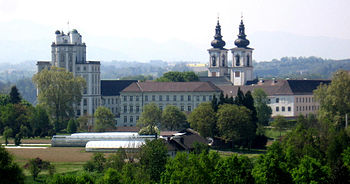HEIMSUCHUNG VON MARIA UND ELISABETH (THE “VISITATION”) 1460, KREMSMÜNSTER ABBEY, KREMSMÜNSTER,
UPPER AUSTRIA
AROUND THE WORLD AND THROUGH THE CENTURIES WITH THE UNBORN
CHRIST CHILD
Heimsuchung von Maria und Elisabeth (Mary and Elisabeth Meeting)
In Christian art Mary’s pregnancy was broached not only in scenes with Jesus as an unborn child but also in pictures of the virgin mother by herself or in association with the Eucharist. Depending on how realistic or symbolic the picture was meant to be, her pregnancy was made evident as a rounded belly, by showing the figure of a child, or by having “IHS” marked on Mary’s stomach.
The original portrayal of this theme was the veneration with which, during her pregnancy, Elisabeth greeted Mary: “Blessed are you among women, and blessed is the fruit of your womb!” (Luke 1,42) This Bible text became widespread due to the “Ave Maria” (Hail Mary) which became part of the Advent liturgy in the 7th and 8th centuries and as of the 13th century had become one of the most important Christian prayers. In medieval times portrayals of Mary and Elisabeth meeting (the “Visitation”) became very common. From around the year 1300 the children were shown in front of their mothers’ bellies as can be seen in this painting from Kremsmünster (around 1460).
“John was ‘filled with the Holy Spirit even from his mother’s womb’ by Christ himself, whom the Virgin Mary had just conceived by the Holy Spirit. Mary’s visitation to Elizabeth thus became a visit from God to his people.” Catechism of the Catholic Church, Article 8, 717.
 To purchase this book, click here: http://unbornwordalliance.com/how_to_order.htm
To purchase this book, click here: http://unbornwordalliance.com/how_to_order.htm
Visit the website: Unborn Word Alliance
Visit the blog version of: Unborn Word of the day


